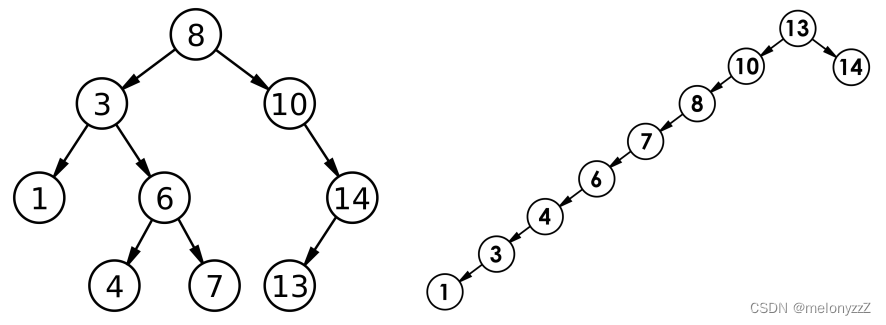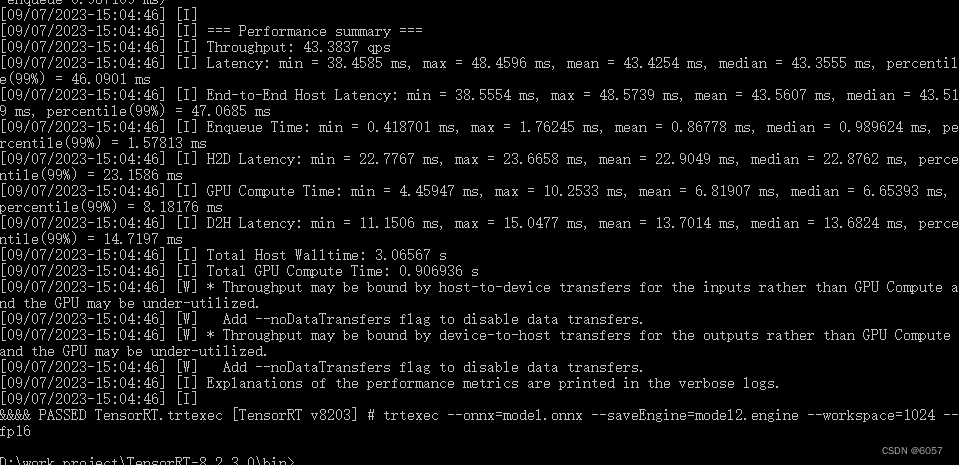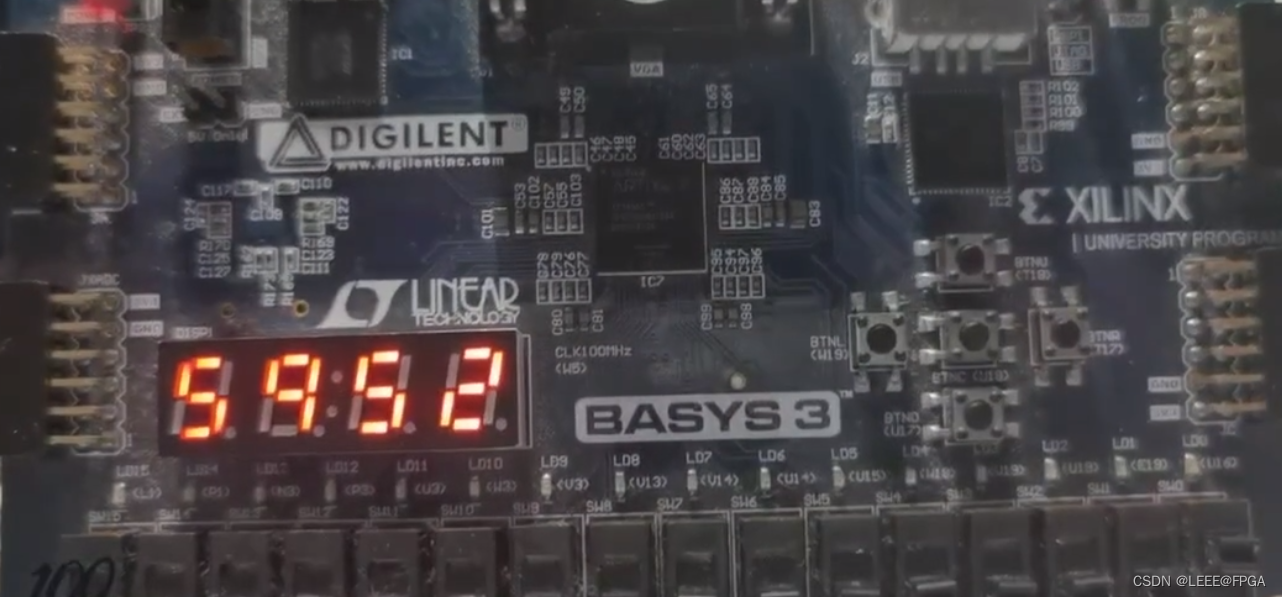目录
一、概念
二、实现
2.1 - BST.h
2.2 - test.cpp
三、应用
四、性能分析
一、概念
二叉搜索树(BST,Binary Search Tree),又称二叉排序树或二叉查找树。
二叉搜索树是一棵二叉树,可以为空;如果不为空,满足以下性质:
-
非空左子树的所有键值小于其根节点的键值
-
非空右子树的所有键值大于其根节点的键值
-
左、右子树本身也都是二叉搜索树。

二、实现
2.1 - BST.h
#pragma once
#include <stack>
#include <iostream>
template<class K>
struct BSTNode
{BSTNode<K>* _left;BSTNode<K>* _right;K _key;
BSTNode(const K& key = K()): _left(nullptr), _right(nullptr), _key(key){ }
};
template<class K>
class BST
{typedef BSTNode<K> BSTNode;
public:/*---------- 构造函数和析构函数 ----------*/// 默认构造函数BST() : _root(nullptr){ }
// 拷贝构造函数(实现深拷贝)BST(const BST<K>& t){_root = Copy(t._root);}
// 析构函数~BST(){Destroy(_root);}
/*---------- 赋值运算符重载 ----------*/// 利用上面写好的拷贝构造函数实现深拷贝BST<K>& operator=(BST<K> tmp){std::swap(_root, tmp._root);return *this;}
/*---------- 插入 ----------*/// 非递归写法bool Insert(const K& key){if (_root == nullptr){_root = new BSTNode(key);return true;}
BSTNode* parent = nullptr;BSTNode* cur = _root;while (cur){parent = cur;if (key < cur->_key)cur = cur->_left;else if (key > cur->_key)cur = cur->_right;elsereturn false;}
cur = new BSTNode(key);if (key < parent->_key)parent->_left = cur;elseparent->_right = cur;return true;}
// 递归(Recursion)写法bool InsertRecursion(const K& key){return _InsertRecursion(_root, key);}
/*---------- 删除 ----------*/// 非递归写法bool Erase(const K& key){BSTNode* parent = nullptr;BSTNode* cur = _root;while (cur){if (key < cur->_key){parent = cur;cur = cur->_left;}else if (key > cur->_key){parent = cur;cur = cur->_right;}else{if (cur->_left == nullptr) // 左子树为空{if (parent == nullptr) // 或者 cur == _root{_root = cur->_right;}else{if (parent->_left == cur)parent->_left = cur->_right;elseparent->_right = cur->_right;}}else if (cur->_right == nullptr) // 右子树为空{if (parent == nullptr) // 或者 cur == _root{_root = cur->_left;}else{if (parent->_left == cur)parent->_left = cur->_left;elseparent->_right = cur->_left;}}else // 左、右子树非空{// 找到左子树中关键字最大的节点(或者找到右子树中关键字最小的节点)BSTNode* parentLeftMax = cur;BSTNode* leftMax = cur->_left;while (leftMax->_right){parentLeftMax = leftMax;leftMax = leftMax->_right;}// 让 leftMax 指向的节点代替 cur 指向的节点,然后删除 leftMax 指向的节点,// 这样就转换成了上面的情况std::swap(cur->_key, leftMax->_key);if (parentLeftMax->_left == leftMax) // 或者 parentLeftMax == curparentLeftMax->_left = leftMax->_left;elseparentLeftMax->_right = leftMax->_left;cur = leftMax;}delete cur;return true;}}return false;}
// 递归写法bool EraseRecursion(const K& key){return _EraseRecursion(_root, key);}
/*---------- 查找 ----------*/// 非递归写法bool Search(const K& key) const{BSTNode* cur = _root;while (cur){if (key < cur->_key)cur = cur->_left;else if (key > cur->_key)cur = cur->_right;elsereturn true;}return false;}
// 递归写法bool SearchRecursion(const K& key) const{return _SearchRecursion(_root, key);}
/*---------- 中序遍历 ----------*/// 非递归写法void InOrder() const{std::stack<BSTNode*> st;BSTNode* cur = _root;while (cur || !st.empty()){while (cur){st.push(cur);cur = cur->_left;}BSTNode* top = st.top();st.pop();std::cout << top->_key << " ";cur = top->_right;}std::cout << std::endl;}
// 递归写法void InOrderRecursion() const{_InOrderRecursion(_root);std::cout << std::endl;}
private:BSTNode* Copy(BSTNode* root){if (root == nullptr)return nullptr;
BSTNode* copyRoot = new BSTNode(root->_key);copyRoot->_left = Copy(root->_left);copyRoot->_right = Copy(root->_right);return copyRoot;}
void Destroy(BSTNode*& root){// 【注意:root 为 _root 或者某个节点的左或右指针的引用】if (root == nullptr)return;
Destroy(root->_left);Destroy(root->_right);delete root;root = nullptr;}
bool _InsertRecursion(BSTNode*& root, const K& key){// 【注意:root 为 _root 或者某个节点的左或右指针的引用】if (root == nullptr){root = new BSTNode(key);return true;}
if (key < root->_key)_InsertRecursion(root->_left, key);else if (key > root->_key)_InsertRecursion(root->_right, key);elsereturn false;}
bool _EraseRecursion(BSTNode*& root, const K& key){// 【注意:root 为 _root 或者某个节点的左或右指针的引用】if (root == nullptr)return false;
if (key < root->_key)_EraseRecursion(root->_left, key);else if (key > root->_key)_EraseRecursion(root->_right, key);else{BSTNode* tmp = root;if (root->_left == nullptr)root = root->_right;else if (root->_right == nullptr)root = root->_left;else{BSTNode* leftMax = root->_left;while (leftMax->_right){leftMax = leftMax->_right;}std::swap(leftMax->_key, root->_key);return _EraseRecursion(root->_left, key);}delete tmp;return true;}}
bool _SearchRecursion(BSTNode* root, const K& key) const{if (root == nullptr)return false;
if (key < root->_key)_SearchRecursion(root->_left, key);else if (key > root->_key)_SearchRecursion(root->_right, key);elsereturn true;}
void _InOrderRecursion(BSTNode* root) const{if (root == nullptr)return;
_InOrderRecursion(root->_left);std::cout << root->_key << " ";_InOrderRecursion(root->_right);}
private:BSTNode* _root;
};2.2 - test.cpp
#include "BST.h"
using namespace std;
void TestBST1()
{int arr[] = { 8, 3, 1, 10, 6, 4, 7, 14, 13 };BST<int> t1;for (auto e : arr){t1.Insert(e);}t1.InOrder(); // 1 3 4 6 7 8 10 13 14
BST<int> t2(t1);t2.InOrder(); // 1 3 4 6 7 8 10 13 14
BST<int> t3;t3 = t1;t1.InOrder(); // 1 3 4 6 7 8 10 13 14
// 左子树为空t1.Erase(4);t1.InOrder(); // 1 3 6 7 8 10 13 14t1.Erase(6);t1.InOrder(); // 1 3 7 8 10 13 14// 右子树为空t1.Erase(14);t1.InOrder(); // 1 3 7 8 10 13// 左、右子树非空t1.Erase(8);t1.InOrder(); // 1 3 7 10 13
cout << t1.Search(8) << endl; // 0cout << t1.Search(7) << endl; // 1
}
void TestBST2()
{int arr[] = { 8, 3, 1, 10, 6, 4, 7, 14, 13 };BST<int> t;for (auto e : arr){t.InsertRecursion(e);}t.InOrderRecursion(); // 1 3 4 6 7 8 10 13 14
// 左子树为空t.EraseRecursion(4);t.InOrderRecursion(); // 1 3 6 7 8 10 13 14t.EraseRecursion(6);t.InOrderRecursion(); // 1 3 7 8 10 13 14// 右子树为空t.EraseRecursion(14);t.InOrderRecursion(); // 1 3 7 8 10 13// 左、右子树非空t.EraseRecursion(8);t.InOrderRecursion(); // 1 3 7 10 13
cout << t.SearchRecursion(8) << endl; // 0cout << t.SearchRecursion(7) << endl; // 1
}
int main()
{TestBST1();TestBST2();return 0;
}
三、应用
-
K 模型:结构体中只需要存储关键码 key,关键码即为需要搜索到的值。
例如,要判断一个单词是否拼写正确,我们首先把词库中的每个单词作为 key,构建一棵二叉搜索树,然后在这棵二叉搜索树中检索单词是否存在,若存在则表明拼写正确,不存在则表明拼写错误。
-
KV 模型:每个关键码 key,都有与之对应的值 value,即 <key, value> 的键值对。
这种模型在现实生活中也很常见:
-
比如英汉词典就是英文与中文的对应关系,通过英文可以快速找到与其对应的中文,英文单词与其对应的中文 <word, Chinese> 就构成一种键值对。
-
再比如统计单词次数,统计成功后,给定单词就可以快速找到其出现的次数,单词与其出现的次数 <word, count> 就构成一种键值对。
BST.h:#pragma once #include <iostream> template<class K, class V> struct BSTNode {BSTNode<K, V>* _left;BSTNode<K, V>* _right;K _key;V _value; BSTNode(const K& key = K(), const V& value = V()): _left(nullptr), _right(nullptr), _key(key), _value(value){ } }; template<class K, class V> class BST {typedef BSTNode<K, V> BSTNode; public:BST() : _root(nullptr){ } BST(const BST<K, V>& t){_root = Copy(t._root);} ~BST(){Destroy(_root);} BST<K, V>& operator=(BST<K, V> tmp){std::swap(_root, tmp._root);return *this;} bool Insert(const K& key, const V& value){return _Insert(_root, key, value);} bool Erase(const K& key){return _Erase(_root, key);} BSTNode* Search(const K& key) const{return _Search(_root, key);} void InOrder() const{_InOrder(_root);std::cout << std::endl;} private:BSTNode* Copy(BSTNode* root){if (root == nullptr)return nullptr; BSTNode* copyRoot = new BSTNode(root->_key, root->_value);copyRoot->_left = Copy(root->_left);copyRoot->_right = Copy(root->_right);return copyRoot;} void Destroy(BSTNode*& root){// 【注意:root 为 _root 或者某个节点的左或右指针的引用】if (root == nullptr)return; Destroy(root->_left);Destroy(root->_right);delete root;root = nullptr;} bool _Insert(BSTNode*& root, const K& key, const V& value){// 【注意:root 为 _root 或者某个节点的左或右指针的引用】if (root == nullptr){root = new BSTNode(key, value);return true;} if (key < root->_key)_Insert(root->_left, key, value);else if (key > root->_key)_Insert(root->_right, key, value);elsereturn false;} bool _Erase(BSTNode*& root, const K& key){// 【注意:root 为 _root 或者某个节点的左或右指针的引用】if (root == nullptr)return false; if (key < root->_key)_Erase(root->_left, key);else if (key > root->_key)_Erase(root->_right, key);else{BSTNode* tmp = root;if (root->_left == nullptr)root = root->_right;else if (root->_right == nullptr)root = root->_left;else{BSTNode* leftMax = root->_left;while (leftMax->_right){leftMax = leftMax->_right;}std::swap(leftMax->_key, root->_key);return _Erase(root->_left, key);}delete tmp;return true;}} BSTNode* _Search(BSTNode* root, const K& key) const{if (root == nullptr)return nullptr; if (key < root->_key)_Search(root->_left, key);else if (key > root->_key)_Search(root->_right, key);elsereturn root;} void _InOrder(BSTNode* root) const{if (root == nullptr)return; _InOrder(root->_left);std::cout << root->_key << " : " << root->_value << std::endl;_InOrder(root->_right);} private:BSTNode* _root; };test.cpp:#include "BST_KV.h" using namespace std; void TestBST1() {BST<string, string> t;t.Insert("insert", "插入");t.Insert("erase", "删除");t.Insert("search", "查找");t.Insert("left", "左边");t.Insert("right", "右边");// 输入英文单词,找到对应的中文string str;while (cin >> str){BSTNode<string, string>* ret = t.Search(str);if (ret)cout << str << "对应的中文是:" << ret->_value << endl;elsecout << "单词拼写错误,词库中没有此单词!" << endl;} } void TestBST2() {string arr[] = { "苹果", "西瓜", "苹果", "西瓜", "苹果", "苹果", "西瓜", "苹果", "香蕉", "苹果", "香蕉" };BST<string, int> t;// 统计每种水果出现的次数for (const auto& str : arr){BSTNode<string, int>* ret = t.Search(str);if (ret == nullptr)t.Insert(str, 1);elseret->_value += 1;}t.InOrder();// 苹果 : 6// 西瓜: 3// 香蕉 : 2 } int main() {// TestBST1();TestBST2();return 0; } -
四、性能分析
在二叉搜索树的插入和删除操作中,都必须先进行查找操作,所以查找的效率就代表了各个操作的性能。
对含 n 个节点的二叉搜索树,若每个节点查找的概率相等,则二叉搜树的平均查找长度是节点在二叉搜树树的深度的函数,即节点越深,比较次数越多。
但对于同一个关键码集合,如果各关键码插入的次序不同,可能得到不同结构的二叉搜索树,例如:

最好情况下,二叉搜索树为完全二叉树(或者接近完全二叉树),其平均比较次数为 。
最坏情况下,二叉搜索树退化为单支树(或者类似单支树),其平均比较次数为 。
如果退化成单支树,二叉搜树的性能就丢失了,那么能否改进,不论按照什么次序插入关键码,二叉搜索树的性能都能达到最优?
后续所要学习的 AVL 树和红黑树就可以解决上述问题。








![磁盘分析 wiztree[win32] baobab[linux]](https://img-blog.csdnimg.cn/2183f97b8fa54e88a64681fa417a5a17.png)


